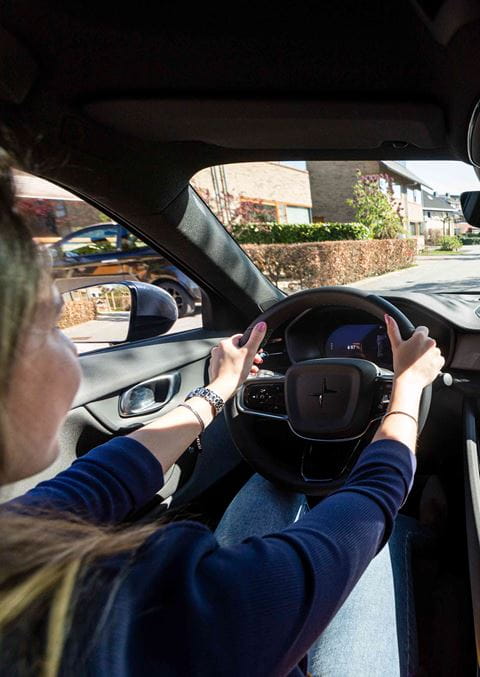
Electrification is everywhere – but how safe are electric vehicles?
The automotive industry is currently experiencing a massive transition towards zero-emissions: the rise of the electric car. All over the world, motorists, fleet managers and business leaders are considering making the switch. And there’s one question that always seems to pop up: are electric vehicles safe to drive?
This blog was originally published by ALD Automotive | LeasePlan, now Ayvens.
It’s important to note that safety is relative – driving can never be completely risk free. But by comparing EVs with conventional options, we can determine which carries the higherrisk, and by how much. Here, we explore the most important things to know about EV safety, so you can make an informed decision!
No conventional engine means more safety benefits
An EV doesn’t need an internal combustion engine (ICE) to power it; just a battery and an electric motor. Most EV designs use the battery pack as a structural part of the vehicle’s platform. This spreads the powertrain much more evenly throughout the vehicle, enabling more efficient energy absorption in the event of a crash. Because of the lower centre of gravity made possible by this design, EVs are also less likely to spin out in collisions or experience rollovers.

Regenerative braking for safer stopping
Electric cars use a technology known as ‘regenerative braking’. This simply means the vehicle will decelerate as soon as the driver lifts their foot off the accelerator – even if they don’t press the brake pedal. In a fast-moving situation on the road, regenerative braking allows the car to slow down before the motorist has actively decided to brake.
This is an important safety feature: it reduces the stopping distance and makes a collision less likely. Of course, EVs still have brake pedals that must be applied. But, in many circumstances, many EV motorists report needing to use the brake pedal far less than in an ICE model.
Turning up the volume
A common criticism directed at EVs is that they’re too quiet. This criticism is not unfounded: a 2014 study found that EVs were 40% more likely to be involved in accidents with pedestrians, with lack of vehicle noise being cited as the key factor. As a result, EV manufacturers are now required to include noise-emitting devices on new vehicles. Since July 2021, this has also been a requirement for existing vehicles in the EU.
Sounds must be emitted at a minimum frequency of 56 decibels – roughly the equivalent of an indoor conversation – and must reflect the car’s behaviour. If a car is speeding up, for example, the pitch of the noise being emitted should rise. This solution goes a long way to making our roads safer for all who use them.
Thermal runaway: What you need to know
Without a petrol engine, there’s no chance of volatile liquids spilling – and potentially catching fire – in a crash situation. An electric battery is not without risks, however. The worst-case scenario for an EV is known as ‘thermal runaway’, a chain reaction within a battery cell that, once started, is very difficult to stop. This typically happens if the battery gets overheated – and a major cause of overheating is overcharging. Because of this risk, fast chargers will only fill up an electric battery to 80% capacity on fast speed, after that the charge speed will drop.
Although thermal runaway is a serious issue, it doesn’t mean your EV will spontaneously combust. The warning signs for thermal runaway are normally obvious before the situation becomes life-threatening, giving motorists time to move to a safe distance. And like all discussions of safety, the risk is relative. Keep in mind that EVs are 0.3% likely to catch fire, compared to1.05% of petrol-powered cars.
Heavier EVs bring higher risk to pedestrians
An EV contains fewer components than a petrol-powered car, but the overall weight of an EV is higher – 340kg more, on average. Some recent EV models are very heavy indeed, such as the GMC Hummer EV, which weighs in at over four tonnes.
There’s a direct correlation between pedestrian fatalities and the weight of the vehicle involved in the incident. On the other hand, motorists driving heavier vehicles are less likely to sustain injuries.
What’s the overall risk assessment?
It’s clear that electric cars offer valuable safety advantages over ICE models: passengers experience reduced forces in crash situations and can access a wide range of additional safety features. Even so, the electric battery does come with certain downsides, such as the risk of thermal runaway, while the vehicle’s extra weight poses an increased risk to pedestrians. Whether you’re managing a business fleet or looking for your next personal vehicle, it’s important to consider both sides of the safety argument – but for us at LeasePlan, there’s no doubt that, compared to ICE vehicles, EVs are the safer option overall.
Our net-zero commitment
LeasePlan is leading the transition to zero-emission mobility and has set itself the goal to achieve net-zero tailpipe emissions from its funded fleet by 2030. As a founding member of the EV100 – a global initiative of forward-looking companies committed to accelerating the transition to EVs – sustainable mobility is at the heart of everything we do.


